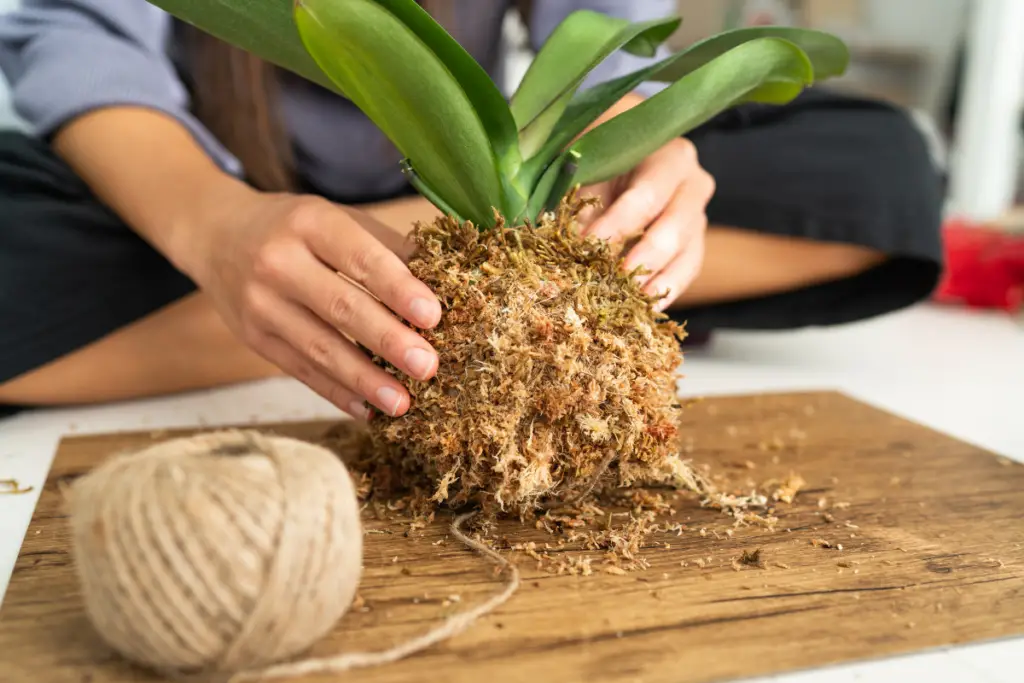Sphagnum moss is a popular choice for orchid enthusiasts because of its ability to retain moisture and provide a stable growing environment.
However, using sphagnum moss with orchids can be tricky, and if done incorrectly, it can lead to root rot and other problems.
In this article, we will explore the dos and don’ts of using sphagnum moss with orchids.
First and foremost, it is important to understand that sphagnum moss should not be used as the sole growing medium for orchids.
Instead, it should be used as an additive to other growing mediums, such as bark or perlite. When using sphagnum moss, it is crucial to ensure that it is of high quality and free of any contaminants.
Additionally, it is important to use the correct amount of sphagnum moss to avoid over-saturation and root rot.
By following these guidelines, orchid enthusiasts can enjoy the benefits of sphagnum moss without risking the health of their plants.

Table of Contents
Understanding Sphagnum Moss
Sphagnum moss is a type of plant that grows in bogs, swamps, and other wetlands.
It is commonly used in gardening and horticulture because of its ability to retain moisture and provide a suitable growing environment for plants.
In this section, we will discuss the characteristics of sphagnum moss and how it can be used with orchids.
Characteristics of Sphagnum Moss
Sphagnum moss is a type of moss that grows in wet environments. It is composed of long, fibrous strands that can absorb and retain large amounts of water.
Sphagnum moss is often used in gardening and horticulture because of its ability to hold moisture and create a suitable growing environment for plants.
One of the unique characteristics of sphagnum moss is its acidity. Sphagnum moss is naturally acidic, with a pH range of 3.5 to 4.5.
This acidity can be beneficial for some plants, including orchids, which prefer slightly acidic growing conditions.
Using Sphagnum Moss with Orchids
Sphagnum moss can be used with orchids in a variety of ways. One common use is as a growing medium for orchids.
When used as a growing medium, sphagnum moss can provide a suitable environment for orchids to grow and thrive.
To use sphagnum moss as a growing medium, it should first be soaked in water to hydrate the fibers.
The orchid can then be planted directly into the moss. Sphagnum moss should be monitored regularly to ensure that it remains moist but not waterlogged.
Another way to use sphagnum moss with orchids is as a top dressing. A thin layer of sphagnum moss can be placed on top of the orchid’s growing medium to help retain moisture and create a more humid environment.
Sphagnum Moss Benefits for Orchids
Sphagnum moss is a popular growing medium for orchids. It is a natural and renewable resource that provides several benefits to orchids.
Here are some of the benefits of using sphagnum moss for orchids:
Improved Moisture Retention
One of the most significant benefits of sphagnum moss for orchids is its ability to retain moisture.
Sphagnum moss can hold up to 20 times its weight in water, which makes it an excellent growing medium for orchids that require high levels of humidity.
The moisture-absorbing qualities of sphagnum moss ensure that orchids receive proper irrigation, promoting healthy growth.
Enhanced Air Circulation
Sphagnum moss is a porous material that allows for good air circulation around the roots of orchids. This feature is essential for orchids because their roots need oxygen to thrive.
The air circulation provided by sphagnum moss helps prevent root rot and other fungal diseases that can occur in stagnant, moist conditions.
Disease Prevention
Sphagnum moss has antimicrobial properties that help prevent the growth of harmful bacteria and fungi.
This feature is particularly useful for orchids because they are susceptible to fungal diseases such as root rot.
Using sphagnum moss as a growing medium can help prevent the spread of disease and promote healthy orchid growth.
In summary, sphagnum moss provides several benefits for orchids, including improved moisture retention, enhanced air circulation, and disease prevention.
These features make sphagnum moss an excellent choice for orchid growers who want to promote healthy growth and prevent disease.
- 【Package Include】You will receive 2 quarts(Appx.3oz) sphagnum moss, it will swell after absorbing water, it helps the plants to retain water while hiding the dirt, and looks good, these carnivorous plant soil mix can re-potting 1-2 medium plants or 3-4 small plants.
- 【Premium Material】It is good quality pure natural dry moss, free of twigs, roots, dirt clods or any other debris, not contain any artificial colourings, it have good water retention and drainage, excellent ventilation, contains varieties of nutrients, which can meet needs of carnivorous plants, not easy to spoil, can be used for a long time.
- 【Wide Application】You can use these orchid moss as nutritional succulent soil for plants, fern, venus flytrap plants, carnivorous plants, also as layering decoration for succulents, or use as egg-laying and incubation medium, substrate for reptile or amphibians terrariums.
- 【Multi-use】Dried moss can use for make terrarium moss crafts, floral design or mini gardens, air plant terrariums, fill hanging basket line, decorate wreaths, natural lawn base for mini landscaping and scenery model, good filler of your faux houseplants.
- 【Warm Tips】Please watering when the peat moss is not completely dry. Once it is dry, it will difficult to re-absorb water. And if you find organic moss is entangled with the roots when replacing it, please do not pull it in case break the roots. You could soak and shake in water to wash off the old sphagnum mo
Prices pulled from the Amazon Product Advertising API on:
Product prices and availability are accurate as of the date/time indicated and are subject to change. Any price and availability information displayed on [relevant Amazon Site(s), as applicable] at the time of purchase will apply to the purchase of this product.
How to Use Sphagnum Moss with Orchids
Sphagnum moss is a popular growing medium for orchids due to its ability to retain moisture while still allowing for adequate drainage. Here are some tips on how to use sphagnum moss with orchids.
Potting
When potting orchids in sphagnum moss, it is important to remember not to pack the moss too tightly.
This can cause the roots to become compressed and lead to root rot. Instead, gently place the orchid in the moss and use stakes or clips to hold it in place.
Watering
When watering orchids grown in sphagnum moss, it is important to soak the moss thoroughly. This can be done by placing the pot in a bowl of water for 15-30 minutes.
Afterward, allow the excess water to drain out before placing the pot back in its normal location. Be careful not to overwater, as this can lead to root rot.
Re-Potting
Over time, sphagnum moss will break down and become compacted, which can lead to poor drainage and root rot.
When it is time to re-pot your orchid, gently remove it from the old moss and trim away any dead or rotting roots. Then, place the orchid in fresh sphagnum moss and stake it in place.
It is important to note that sphagnum moss should be changed every 12-18 months to prevent compaction and ensure proper drainage.
Overall, sphagnum moss can be a great growing medium for orchids when used correctly.
By following these tips, orchid enthusiasts can successfully grow and care for their plants using sphagnum moss.
Orchid Requirements
Lighting
Orchids require a good amount of light to grow and thrive. However, direct sunlight can be harmful to the plants.
It is recommended to place orchids in a location where they can receive bright, indirect light.
The amount of light required varies depending on the type of orchid. Some orchids require more light than others.
It is important to research the specific needs of the orchid in question to ensure it receives the appropriate amount of light.
Temperature
Orchids prefer temperatures between 60°F (15.5°C) and 80°F (26.5°C). They can tolerate temperatures outside of this range, but it is important to avoid extreme fluctuations in temperature.
Temperatures that are too high or too low can cause damage to the plant.
Humidity
Orchids require a high level of humidity to thrive. The ideal humidity level for orchids is between 40% and 70%.
In dry environments, it may be necessary to increase the humidity level around the plant. This can be done by using a humidifier, placing a tray of water near the plant, or misting the leaves with water.
It is important to avoid getting water on the flowers or buds as this can cause damage.
Watering
Orchids require a moderate amount of water. Overwatering can be harmful to the plant, so it is important to allow the soil to dry out between waterings.
The frequency of watering depends on the type of orchid, the size of the pot, and the environment. It is recommended to water orchids early in the day to allow the plant to dry before nightfall.
When watering, it is important to water the soil directly and avoid getting water on the leaves or flowers.
In summary, orchids require bright, indirect light, temperatures between 60°F and 80°F, high humidity levels, and moderate watering.
It is important to research the specific needs of the orchid in question to ensure it receives the appropriate care.
Troubleshooting Common Problems
Overwatering
Overwatering is a common problem with orchids grown in sphagnum moss. Signs of overwatering include yellowing leaves, mushy roots, and a foul smell.
To fix this problem, the orchid should be removed from the pot and the sphagnum moss should be replaced with fresh, dry moss.
The roots should be inspected for any signs of rot or damage and any affected roots should be trimmed off with sterile scissors.
The orchid should be left to dry out for a few days before being repotted in fresh moss.
Underwatering
Underwatering is another common problem with orchids grown in sphagnum moss. Signs of underwatering include dry, brittle leaves and roots.
To fix this problem, the orchid should be watered thoroughly until the moss is saturated. The orchid should be left to drain for a few minutes before being returned to its pot.
It is important to not let the orchid sit in standing water as this can lead to root rot.
Fungal Infection
Fungal infections can occur in orchids grown in sphagnum moss if the moss is kept too wet or if the orchid is overwatered.
Signs of a fungal infection include brown or black spots on the leaves or roots, as well as a foul smell.
To treat a fungal infection, the affected areas should be removed with sterile scissors and the orchid should be treated with a fungicide.
It is important to not let the moss become too wet as this can lead to further fungal infections.
In summary, overwatering, underwatering, and fungal infections are common problems that can occur when growing orchids in sphagnum moss.
By following proper watering techniques and keeping an eye out for any signs of issues, these problems can be easily avoided or treated.
Conclusion
Sphagnum moss is a valuable tool for orchid growers. It can be used in a variety of ways to help orchids thrive. However, it is important to use it correctly to avoid any negative effects on the plants.
When using sphagnum moss, it is important to ensure that it is of high quality, such as New Zealand sphagnum moss.
This type of moss has longer strands, greater strength, and high resistance to rot, making it ideal for orchid growing.
It is also important to use sphagnum moss in the right manner. Packing the moss too tightly can reduce the spaces between the fibers, making it difficult for the roots to breathe.
On the other hand, using too little moss can cause the roots to dry out too quickly.
When repotting orchids in sphagnum moss, it is recommended to soak the moss first to ensure it is fully hydrated. This will help the moss retain water and provide a moist environment for the roots.
Overall, sphagnum moss can be a useful and effective tool for orchid growers when used correctly. With the right quality and application, it can help orchids thrive and flourish.
- How to Build a Planter Box for Bamboo: A Step-by-Step Guide

- Can Robotic Lawnmowers Handle Steep Slopes?

- Do You Need a Specific Lawn for a Robotic Lawnmower? Expert Advice

- Are Robotic Lawnmowers Safe for Pets and Children? Safety Features of Robotic Lawnmowers

- Why Use Robotic Lawnmowers? Advantages of Using a Robotic Lawnmower

- Is the GARDENA SILENO City 300 Cordless or Corded? A Clear Answer















